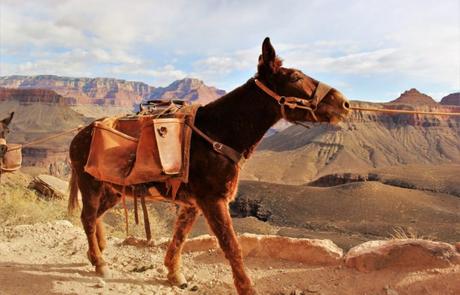
Most people don't know this, but I have a personal history with the Grand Canyon. My parents took me and my sister for the first time when I was 10 years old. Back then I had the National Parks Passport, though before this we'd spent most of our family vacations at Disney.
By the time we left, the Canyon had implanted me with a travel bug. I can honestly say it was that trip that inspired me to start exploring.
But despite living in San Diego for almost 12 years, I hadn't been back to hike the Canyon since. So when we first considered going for a trip in December, I wasn't even sure Grand Canyon winter hiking was a possibility. It had been summer when I was there the first time- but I was desperate to see it blanketed in snow.
At over 7,000 feet of altitude, I knew things got cold at the South Rim, and I remember hearing that the park closes the North Rim to visitors each winter. I immediately assumed that meant the iconic Rim-to-Rim hike would be completely out of the question. What. A. Bummer. That hike has been at the top of our backpacking list for ages!
Luckily, after a bit of research, I came across an obvious solution to our problem. With no services open on the North Rim, we'd just have to turn around and hike back out to the South Rim! Instead of Rim-to-Rim, we'd hike Rim-to-Rim-to-Rim (before you get excited, they don't make stickers for this one).
Now, Annelise, a warm-blooded California native, was not nearly as enthusiastic about my Grand Canyon Winter backpacking proposal. So I promised that Rim-to-Rim-to-Rim would not only be spectacular, but that it wouldn't be THAT cold. And after she gave a reluctant go-ahead, we faxed in a last-minute backcountry permit request to the Grand Canyon backcountry office.
It's worth noting here that while I love being spontaneous, I might have gotten lucky on this one. It's usually recommended that you plan your trip and fax your requests in about four months in advance.
Fortunately we were able to get email confirmation within two days. They had approved our second route option and our earlier set of dates, which meant we only had a little time to gear up!
Grand Canyon Winter Hiking Gear
I can't stress enough the importance of reliable gear on a thru-hike, especially a cold one, and we've talked in depth about gear in past posts, from our experiences . But with the notable elevation changes hiking in and out of the canyon, I strongly recommend using hiking Torres Del Paine and backpacking the Trans-Catalina Trail trekking poles

Even if you're able-bodied, poles distribute the brunt of the impact on your joints on both the ascent and descent. And with days in which you lose (or gain and lose) 4,000 plus feet of elevation, it's worth sparing your knees a bit.
Having called the ranger station to double-check conditions, I knew they'd hardly seen any snow yet this season. Still, we took the precaution of ordering YakTrax microspikes

Along with the basic gear, like our sleeping bags (Annelise has a great one from Mountain Hardware), hats, jackets, pants, and gloves, we also purchased new wool base layers

Grand Canyon Winter Backpacking Rim-to-Rim-to-Rim Route
Gear sorted, we drove straight from San Diego to the park and stayed at a hotel just a mile from the Grand Canyon entrance. It's about an eight hour drive, and we broke it up with a solid lunch at the Iron Horse Grill and Restaurant in Salome (64638 US-60, Salome, AZ 85348).
Needless to say, we were still relieved when we arrived at the hotel. Our room had patio access to an indoor courtyard with a jacuzzi and lounge with enough foliage that it almost felt like we were outside.
Good thing we weren't, because when we left at 7:30 the next morning it had snowed a few inches overnight! I was stoked because I had secretly been hoping we'd get to see the Canyon in snow. However, I had to de-ice the car windshield with a surf wax comb. Pro-tip: Always carry an ice scraper!
DAY ONE
After entering the National Park with time to spare, we parked outside the Bright Angel Lodge, walked around the snowy canyon, and went inside for a coffee. Then we packed our bags and headed to the bus stop for the Hiker's Express, which runs from Bright Angel Lodge at 8 and 9 AM.
The last stop is the South Kaibab Trailhead, which would be our starting point for Rim-to-Rim-to-Rim- though you can also hike down Bright Angel Trail. Since we decided we wanted to hike up the Bright Angel Trail on the way out (because it's a bit longer but less steep), we decided to hike down the South Kaibab Trail to switch it up.
Also the South Kaibab Trail is more exposed to direct sun than the Bright Angel Trail, so if snow is an issue, it is generally thought that it will melt on the South Kaibab Trail first. That said, the climb down was an unrelenting 7.5 miles with a loss of 4,720 feet in elevation. Did I mention that trekking poles are so helpful with a full pack?
Still, the first day was filled with wind gusts, spectacular vistas, mule trains, and a history lesson in geology as the rock formations and colors changed at every new angle. After a four-hour downhill hike, we arrived at Bright Angel Campground. For a downhill day, it was admittedly more taxing than we anticipated.
DAY TWO
On day two, we left for Cottonwood Campground at about 9:30 AM. Over a drastically different seven miles, we only gained about 1,600 feet of elevation. While I'd imagine the shade of the canyon walls along Bright Angel Creek would be very welcome during warmer months, we spent most of the morning trying to warm up.
On the upside, and probably one of my favorite things about hiking Rim-to-Rim-to-Rim during the winter, the crowds got smaller and smaller the closer we got to the North Rim. There's something special about finding yourself in a place like the Grand Canyon and not seeing another soul.
At Cottonwood, we found a nice flat site (number three, if memory serves) close to the creek and still in the sun. We soaked up all we could before it tucked behind the Canyon around 4:30 PM.
DAY THREE
Day three, or Big D3 as Annelise affectionately called it, was the one we had been preparing for mentally because it would cover 14 plus miles gaining and then losing 4400 feet. But because we'd return to camp at Cottonwood, we left our tent setup and hiked out early with lighter packs. We left right at sunrise, around 7:30, to ensure we'd make it back to camp before the early winter sunset.
The hike from Cottonwood to the North Rim was as awe-inspiring as it was difficult. We filled our water at Manzanita Rest Area, about two miles from Cottonwood, because the water spigots at other areas of the North Rim are closed in the winter months.
From there, we cruised straight past Roaring Springs, passing only one guided group on the way. The climb to the Supai Tunnel and the Coconino Overlook was narrow and icy in some parts, but there was very little wind. It's worth noting that you can't be too careful here, as this was easily the scariest portion of the trail, situated along fairly sheer cliffs (another reason for poles).
Toward the top, the snow returned, but not enough to warrant our microspikes. Although the view from the top was not quite as striking as the view from the South Rim, we were still elated to have made it. Yet harsher wind and its accompanying chill drove us back down the hill to find some sun.
We hiked back down the .6 miles to the Coconino Overlook, where the view was both spectacular and drenched in sun. Grateful for the reprieve, we stayed here for an hour to have lunch in the sun all by ourselves. And after the refuel, we hiked the seven miles back to Cottonwood, arriving by 3:45 and with enough time to enjoy more sun.
DAY FOUR
On Sunday, Christmas Eve, we left the Cottonwood Campground around 9:30 to get back to Bright Angel Campground. We had initially planned to fill our easy seven-mile, moderate downhill day with a detour to Ribbon Falls, but some signs made us concerned the bridge was closed.
Going backwards from Day Two, the easy downhill slope was covered mostly in shade. We pushed on until we found a nice sunny spot by the creek for lunch. From there it was just a few miles back to Bright Angel Campground, where we arrived by 2:00 PM, greeted by mule deer.
We set up camp in site number 10, next to the creek, and went back to the canteen to play cards outside. After I beat Annelise at Rummy 500, we celebrated with a couple of Bright Angel IPAs inside the canteen before it closed for dinner prep at 4:00 PM. And, because it was Christmas Eve, we were treated by my family to a family-style steak dinner at Phantom Ranch right at 5:00 PM.
They also serve stew to a later crew at 6:30 PM and re-open between eight and ten for the night owls. We spent most evenings confined to our tent to stay warm, but when the sun set we were thrilled to see several people had put up lights to get in the Christmas spirit.
DAY FIVE
With more people nearby, we woke early Monday morning and packed up camp by 8:30 AM. We filled our waters once more, knowing there wouldn't be more until 4.5 miles up at Indian Garden Campground, and hiked up past the River Rest House.
We crossed back over the Colorado River and dawdled a bit soaking up the incredible views.
The Devil's Corkscrew (an intense series of switchbacks) starts shortly after, and slowly but surely we started crossing paths with more people. We continued on past Plateau Point and went straight to Indian Garden Campground, the only other place water was on on the south rim, to have lunch.
Eager to complete our journey, we trekked another 4.5 miles from there to the top of the canyon, where we arrived by 2:00 PM. We had made a reservation at the Bright Angel Lodge-and were so glad we did. We checked in early, had showers and caught the last half of the holiday football game before having dinner.
And even though we couldn't find R2R2R stickers, we'd recommend it anyway.
For the sake of clarity, our backcountry permit request looked like this:
Day 1 - Bright Angel Campground
Day 2 - Cottonwood Campground
Day 3 - Cottonwood Campground
Day 4 - Bright Angel Campground
Day 5 - Out
Please also note that hiking in the Grand Canyon can be extremely dangerous in both winter and summer. Always make sure you consult the park and bring adequate supplies. Every step you take into the canyon is a step you have to take out, and neither shade nor running water is always guaranteed.If you have any questions about our route, what we packed, what we ate, or what we saw, feel free to write us here.


